The Essential Impact of Resistance Training on Improving Recovery and Performance in Athletic Recovery
The Essential Impact of Resistance Training on Improving Recovery and Performance in Athletic Recovery
Blog Article
Strength conditioning holds a vital part in sports recovery, assisting sportspeople recover from injuries and enhance their overall performance. When an athlete gets hurt, their body needs period to heal. However, during this rehabilitation period, it is crucial to preserve strength and mobility to avoid further injuries. Strength training can be tailored to suit the needs of each individual, concentrating on specific muscular areas that may have been impacted by the trauma. This focused method not only aids in rehabilitation but also prepares the individual to come back to their activity more robust than previously.
One of the primary advantages of strength conditioning in rehabilitation is its capability to enhance muscle strength and stamina. When muscular tissues are more powerful, they can more effectively support articulations and reduce the risk of recurrence of injury. For example, an individual healing from a leg injury can gain from workouts that strengthen the thigh muscles and hamstrings. These muscles play a crucial role in stabilizing the leg joint. By including strength conditioning into their rehabilitation plan, athletes can recover their power more effectively and securely.
In addition to developing strength, resistance training also improves mobility and range of movement. Many traumas can result to stiffness in the injured area, causing it difficult for individuals to move freely. Resistance conditioning workouts often involve stretching and lengthening the muscular tissues, which can help reestablish flexibility. For example, incorporating weight bands or dumbbells into stretching programs can enhance the efficacy of these workouts. As flexibility enhances, athletes can execute actions more efficiently, which is essential for peak performance in their activity.
Another crucial factor of resistance conditioning in athletic rehabilitation is its positive impact on psychological health. Healing from an trauma can be a difficult and exasperating experience for athletes. Engaging in resistance conditioning can offer a sense of accomplishment and boost self-esteem. As individuals see improvements in their strength and abilities, they may experience more motivated to continue their rehabilitation process. This psychological uplift can be just as important as the visit site physical advantages, as a optimistic attitude can lead to better results in recovery.
Finally, strength conditioning can help athletes transition back to their activity more seamlessly. Once they have recovered their strength and flexibility, individuals must to practice sport-specific actions to guarantee they are prepared for competition. Strength conditioning can be integrated with sport-specific drills to create a holistic recovery plan. This blend allows individuals to not only recover but also enhance their capabilities. By concentrating on both recovery and performance, resistance conditioning becomes an essential tool in the rehabilitation journey, assisting athletes come back to their activity stronger and more durable.